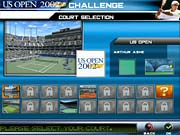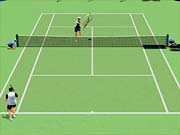In a sparsely populated genre where even the best games have been relatively weak, Strategy First's US Open 2002 is arguably the finest PC-based tennis simulation to date. It is strategic, positional, somewhat realistic, and at times extremely challenging. It is not, however, as exciting or as sophisticated as a quality console tennis game. Although US Open clearly strives to duplicate the ambience, the appearance, and even the menu structure of Sega's Tennis 2K2 and Virtua Tennis for the Dreamcast and Sega Sports Tennis for the PlayStation 2, it is simply not as thrilling. But on the PC, it's currently the only way to go.

Despite the game's title, US Open concerns itself only partly with America's most prominent tennis tournament. In reality, it lets you play at several world-class events, including the British Classic (presumably Wimbledon), the French Classic (presumably Roland Garos), and the Australian Cup (Australian Open). Each surface purportedly behaves as it does in real life, and certainly you'll find the grass courts of Britain play somewhat faster than the red clay of France.
French developer Wanadoo has infused the game with an eclectic mix of 10 real-life touring pros, including stalwarts such as Gustavo Kuerten, Tim Henman, and Todd Martin, and hot newcomers like Tommy Robredo and Elena Dementiava. Sadly, many of the star players you'd hope to find in a game such as this, such as Pete Sampras, Lleyton Hewitt, Serena and Venus Williams, Jennifer Capriati, and even Anna Kournikova, are missing. However, you can unlock a variety of weird and wacky imaginary foes by emerging triumphant in certain disciplines.
In arcade mode, you'll compete in a succession of singles or doubles matches on the court of your choice, each against an increasingly difficult opponent. Exhibition mode lets you play a one-off match with the opponent and court parameters of your choice, while challenge mode gives you an opportunity to set up your own personalized tourney. You may also wish to explore US Open's other gameplay options, including training (against a wall or with the aid of a ball machine), doubles and mixed-doubles competition, and four-player multiplayer tennis over a LAN.
The game's most comprehensive mode, career, isn't a true career in that it doesn't allow you to advance your player from humble beginnings all the way through to the pros. Instead, it offers a series of 10 professional seasons wherein you face increasingly talented opposition and a progressively faster pace. If you perform up to snuff, your ability will improve and you will be propelled through to the next season. Alternately, if you prove you're not quite ready for the next level, you must replay your last season. Given that the tennis becomes incredibly difficult at its more advanced levels, most players will need many hours, days, and perhaps months to reach the successful end of a full 10-season career.
Unfortunately, US Open simply doesn't seem optimized for the PC. Control options, for example, must be set from a separate utility before launching the game. Menu screens do not support mouse control, and the printed manual is woefully short on detailed information and instruction. The automatic save routine is switched off by default, thus forcing you to search for the manual save function, which will in turn activate auto-saving. And on one test machine, the game ground to a halt on several occasions, forcing a complete reboot. To be fair, it ran successfully on a second machine and hasn't been found to be chronically problematic by Strategy First's technical support. It's possible that you may never see any computer lockups and associated operational hassles...but it's possible that you might, too.
Even still, US Open's gameplay is hampered by a variety of irritating problems. At its rookie level, it's so frightfully easy that it's possible to consistently destroy your opponents at a blistering five-minutes-per-set average. In fact, at rookie level, the computer opponents are scarcely capable of notching a single point. Yet US Open becomes positively beastly in advanced modes, where your playing partners are suddenly instilled with uncanny shot placement, inhuman endurance, and an amazing last-second lunge that lets them return seemingly unreturnable shots. Go cross-court on these guys and gals all day; they just don't seem to get tired. And all the way through, shots continually paint the lines as if there were an invisible force-field guarding the perimeters. Lobs virtually always land within the court, and the net is only rarely touched.
Visually, US Open has its moments. Players bounce about between points, wiping sweat from their brow or inspecting their racquets. Facial close-ups reveal reasonable likenesses of their real-life counterparts. Ball boys and line judges surround the court, real-time shadows flit beneath both the ball and the athletes, and all the playing surfaces look their part. However, the proceedings unfold in a stilted manner. Your robotlike, artificially intelligent foes never raise or vary their approach, nor will anyone ever dive to the ground to scoop up a difficult shot. Instead, they'll conduct themselves just as aggressively at the outset as they will during a potential match point. Furthermore, the game sports only two similar-looking camera perspectives, and no replay.

Yet, though it doesn't seem to reproduce the true feel of real human beings playing tennis, US Open is by no means unenjoyable. Like its console peers, it smartly focuses more on preparation and shot selection than exacting racquet-to-ball contact. Particularly at its advanced levels where you're forced to concentrate every second of the way or pay the price, it does a fine job of rewarding patience and timeliness and penalizing forced aggressiveness and ill-timed forays to the net. In fact, if you can live with its idiosyncrasies, you'll find that Wanadoo has built an ultra-strategic affair that plays out like a somewhat more adrenaline-driven game of chess. Mastering the game's many shots and shot variations is not easy but is ultimately well worth the time invested.
For the most part, US Open is pleasing to the ear. Ball thunks and thwaps are accurately portrayed, as are the calls of the chair umpire and the footsteps and grunts of the overextended players. The gallery sounds good too, vociferously cheering long or particularly spectacular rallies, groaning at the less-than-spectacular, and oohing and aahing when applicable. But for some reason, their clamor grows no more frenzied at the end of a match than it is at the beginning. Set and match points are often greeted with a cursory smattering of applause.
Those accustomed to the multifaceted animations, thrilling player movements, and polished presentation and camerawork of Sega's excellent console tennis games may well be disappointed by US Open 2002. Yet beneath its quirks lies a tactical battle that should please anyone who enjoys a slower-paced cranial workout as much as a gamepad-walloping duel. If you must play tennis on your PC, this is the way you should play.